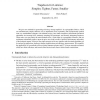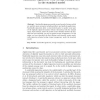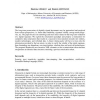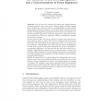569 search results - page 25 / 114 » On the Security of the Digital Signature Algorithm |
IACR
2011
12 years 8 months ago
2011
We give new methods for generating and using “strong trapdoors” in cryptographic lattices, which are simultaneously simple, efficient, easy to implement (even in parallel), a...
CISC
2009
Springer
13 years 6 months ago
2009
Springer
Sanitizable signatures provide several security features which are useful in many scenarios including military and medical applications. Sanitizable signatures allow a semi-trusted...
COMPSEC
2004
13 years 8 months ago
2004
The long-term preservation of digitally signed documents may be approached and analyzed from various perspectives, i.e. future data readability, signature validity, storage media ...
CARDIS
2008
Springer
13 years 10 months ago
2008
Springer
Digital signatures are one of the most important applications of microprocessor smart cards. The most widely used algorithms for digital signatures, RSA and ECDSA, depend on finite...
EUROCRYPT
2004
Springer
14 years 1 months ago
2004
Springer
For the last two decades the notion and implementations of proxy signatures have been used to allow transfer of digital signing power within some context (in order to enable flexi...




